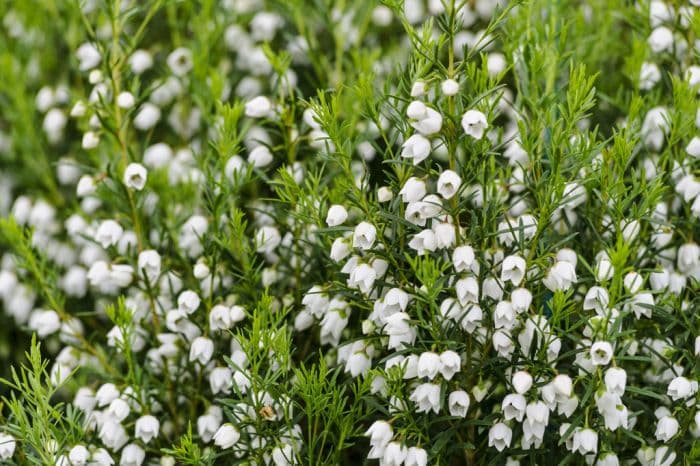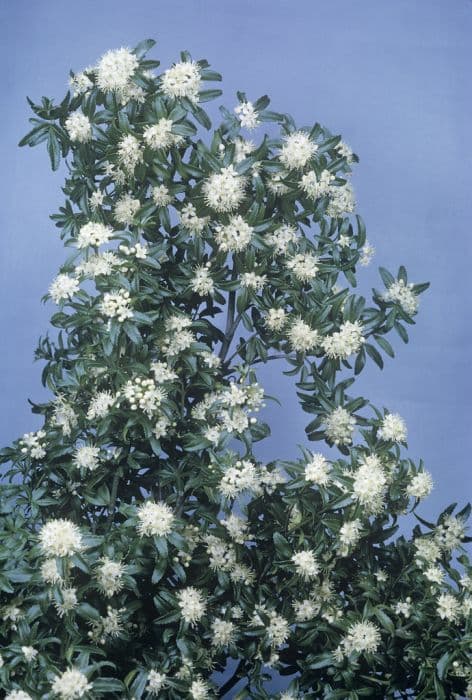Red Boronia Boronia heterophylla 'Ice Charlotte'

ABOUT
Boronia, known specifically as 'Ice Charlotte', is a striking plant characterized by its vibrant displays and aromatic presence. This cultivar typically showcases lush, deep green foliage with a dense and bushy habit. The leaves are typically small, and may have a fine, soft texture which complements their dense arrangement on the branches. The most captivating feature of the 'Ice Charlotte' boronia is its flowers. Blooming profusely, the flowers are noted for their delicate, and often whimsical appearance. They generally present a beautiful contrast of colors, with a lighter, icy pink hue that seems to glow against the dark green backdrop of the foliage. Each flower typically has four petals that may appear almost waxy in texture, and they are arranged in a star-like pattern, radiating from the center of the bloom. The blossoms are known to exude a sweet and pleasant fragrance that can be a delight in any garden setting, often described as intense and reminiscent of citrus or fruity scents. While the description avoids the plant's specific measurements, the 'Ice Charlotte' boronia is known to possess a form that can be visually substantial and well-rounded, contributing to its appealing ornamental qualities that make it a popular choice among gardeners and landscapers seeking a showy yet compact shrub.
About this plant
 Names
NamesFamily
Rutaceae
Synonyms
Red Boronia, Ice Charlotte Boronia
Common names
Boronia heterophylla 'Ice Charlotte'.
 Toxicity
ToxicityTo humans
Boronia does not have a well-documented profile for toxicity to humans. While it is generally recommended to avoid ingesting plants that are not known to be edible, there is no specific information indicating that Boronia is particularly poisonous to humans. No characteristic symptoms of poisoning have been reported. However, as with any plant not meant for consumption, if someone ingests Boronia and experiences adverse symptoms, they should seek medical attention.
To pets
Boronia is not commonly listed among plants that are known to be toxic to pets. However, the lack of documented toxicity does not necessarily mean it is safe for animals to consume. Without specific information on the toxicity of Boronia to pets, it is prudent to prevent pets from ingesting the plant. If a pet does ingest Boronia and shows signs of distress or illness, contact a veterinarian.
 Characteristics
CharacteristicsLife cycle
Perennials
Foliage type
Evergreen
Color of leaves
Green
Flower color
Pink
Height
3 feet (0.91 meters)
Spread
2 feet (0.61 meters)
Plant type
Shrub
Hardiness zones
9
Native area
Australia
Benefits
 General Benefits
General Benefits- Aesthetic Appeal: Adds vibrant pink flowers and dense foliage to gardens, enhancing visual interest.
- Fragrance: The flowers and leaves emit a pleasant, sweet scent that can enrich the sensory experience of a space.
- Habitat Support: Provides food for pollinators such as bees, supporting local ecosystems.
- Overall Versatility: Can be used in various garden designs, including borders, pots, and as a feature plant.
- Drought Tolerance: Once established, it is relatively drought-resistant, requiring less frequent watering.
- Compact Size: Its small stature makes it suitable for gardens with limited space.
- Low Maintenance: Requires minimal pruning and upkeep once established, making it ideal for busy gardeners.
 Medical Properties
Medical PropertiesThis plant is not used for medical purposes.
 Air-purifying Qualities
Air-purifying QualitiesThis plant is not specifically known for air purifying qualities.
 Other Uses
Other Uses- Boronia heterophylla 'Ice Charlotte', commonly known as Red Boronia, can be used as a natural dye for fabrics, where the leaves and flowers impart subtle green and yellow hues, respectively.
- Red Boronia essential oil, extracted from the plant, is often used in perfumery for its intense, floral fragrance that adds depth to perfume blends.
- The flowers of the Red Boronia can serve as an attractive edible garnish for desserts and salads, adding a splash of color with their vibrant pink blooms.
- The wood of Red Boronia plants is sometimes utilized in intricate woodworking projects, such as making small decorative objects or inlay work, due to its fine grain.
- Dried Red Boronia flowers are used in potpourri mixtures, contributing a long-lasting scent that freshens up living spaces.
- Boronia leaves can be infused into oils or vinegars to impart a unique, herby flavor suited for culinary experimentation.
- The Red Boronia plant acts as a habitat enhancer in gardens, providing shelter and food sources for beneficial insects such as bees and butterflies.
- Dried Red Boronia can serve as a natural moth repellent when placed in wardrobes or drawers, keeping clothes free of damage.
- When planted en masse, Red Boronia can be used to stabilize soil and prevent erosion on sloped garden areas due to its rooting system.
- The plant's striking appearance is used in photography and botanical illustration, serving as a subject for artists to capture its beauty.
Interesting Facts
 Feng Shui
Feng ShuiThe Boronia is not used in Feng Shui practice.
 Zodiac Sign Compitability
Zodiac Sign CompitabilityThe Boronia is not used in astrology practice.
 Plant Symbolism
Plant Symbolism- Healing and Therapeutic Properties: Boronia heterophylla, also known as Red Boronia, is often used in aromatherapy for its uplifting and soothing scent, symbolizing emotional healing and the alleviation of stress.
- Uniqueness and Rarity: The 'Ice Charlotte' variety, with its distinct appearance, represents the uniqueness of an individual or situation, symbolizing rarity and special value.
- Beauty and Attraction: With its beautiful flowers, Red Boronia symbolizes attraction and beauty, highlighting the joys of the natural world and the allure of flora.
- Connection to Nature: As a native Australian plant, Red Boronia signifies a deep connection to nature and the environment, emphasizing the importance of conservation and natural heritage.
 Water
WaterRed boronia (Boronia heterophylla 'Ice Charlotte') should be watered regularly to maintain consistent moisture, particularly during its active growth in spring and summer. It will typically require watering once or twice a week, but this can vary based on climate and soil conditions. It's best to check the soil moisture by feeling the top inch of soil; if it's dry, water the plant. Use enough water to dampen the soil thoroughly without waterlogging it, around 1 to 2 gallons each time, depending on the size of your plant and pot.
 Light
LightRed boronia thrives in bright, indirect light and should be placed in a spot where it can receive plenty of filtered sunlight without being exposed to harsh midday sun. An east or west-facing window with some light shade is ideal. Avoid placing it in full shade or direct afternoon sun, as this could either starve the plant of light or cause leaf burn.
 Temperature
TemperatureRed boronia prefers a temperate climate with temperatures ranging from 50°F to 75°F for optimal growth. It can survive brief periods of higher or lower temperatures but prolonged exposure to temperatures below 30°F or above 85°F can be harmful to the plant. The ideal temperature range for red boronia to thrive is between 60°F and 70°F.
 Pruning
PruningRed boronia should be pruned to maintain its shape and encourage bushier growth. Prune after flowering by cutting back the spent flower stems and trimming any straggly growth. This typically happens once a year, but light pruning can be done anytime to remove dead or damaged wood. The best time for a more significant prune is in late winter or early spring before new growth begins.
 Cleaning
CleaningAs needed
 Soil
SoilRed Boronia requires well-draining, acidic soil with a pH between 5.5 and 6.5 for optimal growth. A soil mix comprised of equal parts peat moss, perlite, and loamy soil is ideal to provide the necessary drainage and aeration. Regularly monitor the pH and adjust as necessary to maintain acidity.
 Repotting
RepottingRed Boronia should generally be repotted every two to three years to refresh the soil and encourage continued growth. However, they prefer not to be disturbed too often, so repot only when necessary and handle the root system with care during the process.
 Humidity & Misting
Humidity & MistingRed Boronia thrives in moderate to high humidity levels, ideally ranging from 50% to 70%. This plant benefits from a humid environment but can tolerate lower humidity if other growing conditions, such as watering and soil moisture, are well managed.
 Suitable locations
Suitable locationsIndoor
Provide bright indirect light and maintain high humidity.
Outdoor
Place in partial shade with protection from strong winds.
Hardiness zone
9-11 USDA
 Life cycle
Life cycleBoronia heterophylla 'Ice Charlotte', commonly known as Red Boronia, begins its life cycle as a seed, germinating in the right conditions of moisture and temperature, often requiring a well-drained medium. Seedlings emerge and develop into juvenile plants, showing the characteristic foliage of mature Boronias but not yet flowering. As the plant matures, it enters the vegetative stage where it grows to its full size and the leaves fully develop, showing a deep green or reddish hue. The mature phase is marked by the onset of flowering, when Red Boronia produces an abundance of its distinctive pink or red flowers, usually in spring or early summer. After pollination, which can occur through the aid of insects, the flowers develop into seed capsules which, upon drying, release seeds to begin a new generation. Finally, as a perennial, it can live several years but may have a shorter life span or require rejuvenation in cultivation to prevent it from becoming woody and less floriferous with age.
 Propogation
PropogationPropogation time
Spring-Early Summer
The Boronia heterophylla 'Ice Charlotte', commonly known as Red Boronia, is best propagated using semi-hardwood cuttings. This typically takes place in the summer when the plant’s growth begins to harden. To propagate, a cutting of about 4 to 6 inches (10 to 15 centimeters) is taken from a healthy stem, ensuring that at least two sets of leaves are present. The lower leaves are then removed, and the cut end is dipped in a rooting hormone to encourage root growth. The cutting is inserted into a well-draining potting mix and maintained in a warm, humid environment until roots have developed, which can take several weeks. Regular misting is essential during this period to keep the cutting hydrated. Once the cutting has rooted, it can be transplanted into individual pots to grow on before being planted out.

![Mexican orange [Sundance]](/_next/image?url=https%3A%2F%2Fplants-admin.emdemapps.com%2Fimages%2Fplants%2F%2Fimages%2F604b5381bcf0d.png&w=640&q=75)







![Mexican orange [Goldfingers]](/_next/image?url=https%3A%2F%2Fplants-admin.emdemapps.com%2Fimages%2Fplants%2F%2Fimages%2F604b5bdfad8cd.png&w=640&q=75)